A Transformative Turn towards Sustainability in the Context of Urban-Related Studies? A Systematic Review from 1957 to 2016
Abstract
1. Introduction
2. Transformations to Sustainability: An Emerging, Yet Fuzzy Research Framework
- While some authors argue that the necessary transformations to deal with challenges of GEC and social justice are too deep, urgent and pervasive to be achieved by democratic means and democracy is sometimes queried to be the enemy of nature, Stirling [24] differentiates between two ideal types of political replies to the aforementioned urgent challenges. He differentiates 1. Societal transitions, in his understanding technological innovation towards a pre-defined end as for example global transitions to nuclear power in energy production; and 2. Social transformations, which are more plural, emergent and unruly political-re-alignments, involving social and technical interactions and with no clear-defined end. Contrary to other authors, it is repeatedly the unruly, bottom-up transformations which are based on active democracy rather than top-down structured transitions that achieve the most profound radically progressive social changes. Stirling thereby makes a crucial point concerning the general politics and the specific political instruments of transformations to sustainability.
- The work of Loorbach refers to transition management approaches such as Grin et al. [26] and aims to explain the shift from one regime to another. In a more general way the approach aims to understand how societal changes emerge. In contrast to Stirling, Loorbach sees transformations and transitions as interrelated and not opposing concepts. Transitions are defined as a “non-linear shift from one equilibrium to another” [25] (p. 45) and will lead to the long-term process of a “New Transformation” towards sustainability, which is characterized as a power shift away from powerful elites controlling resources money and power. Loorbach understands incremental changes in so-called niches of markets as the starting point for paradigm change that can pave the way towards more profound changes.
- (1)
- Research determines clear definitions on transformations/transitions to sustainability and also specifically for cities through combining the different research strands of sustainability transformations. This could finally lead to a theory of urban sustainability transformations and the emergence of new debates.
- (2)
- Future research considers transformations as generic term which covers all processes, steps and policies which try to achieve sustainability and which is used in different contexts with different meanings, however lacking scientific clarity and being very close to a catch-all term such as sustainability.
3. Methods
- Firstly, all Web of Science and/or Scopus articles that use the terms urban transformation(s) or transition(s) either in the title, in the abstract or in the keywords were identified, starting with the first occurrence in 1957 until 2016. A total of 902 articles has been found. Some (few) discrepancies occurred in the databases as the same article appeared several times but with different publication years, or book reviews and editorials were classified as research articles, etc. However, those problems were solved on a case-to case base.
- All selected articles were then, in a second step, classified along the following categories: 1. Year of publication; 2. Geographical focus; 3. Journal of publication. The geographical focus of the paper refers to the national level and was (if not already displayed in the title of the article) identified through the abstract. In cases where this did not lead to a result, the geographical focus was classified as “not known.”
- As one of our aims was to evaluate the environmental perspective of urban transformations, we selected in the third step those articles which clearly show a relation to GEC. Based on the abstract, we selected those articles dealing with the use of nature in cities, climate issues, environmental degradation in and caused by cities, urban health- and risk and disaster issues if related to nature and the environment (articles such as [34,35,36] or [37]). 226 articles were selected this way.
- In a subsequent fourth step those 226 articles were then evaluated whether they apply a normative understanding in the sense of urban transformations to sustainability. This means that in this step those articles were selected which understand urban transformations as fundamental, systemic changes causing sustainability shifts in for example infrastructure, behaviour or mobility patterns or cross-sectoral changes in a city and as something which is required to achieve sustainability. All 78 articles identified in step 4 have therefore an explicit normative approach. The difference between the 226 articles which show a relation to environmental aspects (selected in step 3) and the 78 articles which were selected in step 4 is the normative perspective: All the articles of step 4 define as objective of transformation a more sustainable urban environment. In contrast, the articles in step 3 analyse the impact of urban transformations (understood for example as rural-urban migration or as post-socialist transformation) on the environment. The distinction between the articles identified in step 3 and in step 4 is decisive to understand the novelty of T2S research: All articles identified in step 4 have an explicit normative approach which is process-oriented and aims to contribute to the overarching goal of sustainability.
- As a fifth step, we had a detailed look at the 78 articles with a normative understanding of urban transformations. Firstly, we analysed how often these articles have been cited. This was then compared with the number of citations which other articles on urban transformations received. While the number of citations does not necessarily show the impact of the respective article and it is not clear in which context the article has been cited (if this was directly related to urban transformations), this number can serve as an approximation on how the academic community perceived the article. This methodology follows [3], who analysed citations of articles on transformations to sustainability in a similar way.
- Subsequently, the content of the articles has been analysed in order to identify the thematic fields and the empirical cases used in the articles. This, in order to get a deeper understanding of the articles which use urban transformation(s)/transition(s) in a normative way. We differentiated between empirical articles (using one or few case studies) and more theoretical/conceptually oriented articles. From the total of 78 articles, 23 have a theoretical/conceptual focus, while a majority of 55 are based on empirical case studies. This allows us to evaluate how the goal of urban transformations to sustainability has been applied.
4. Results
5. Conclusions
Acknowledgments
Conflicts of Interest
Appendix A
| Cities | 34 |
| Urban Studies | 34 |
| International Journal for Urban and Regional Research IJURR | 21 |
| Journal of Cleaner Production | 19 |
| Habitat International | 17 |
| A/Z ITU Journal of the Faculty of Architecture | 13 |
| European Planning Studies | 13 |
| WIT Transactions on Ecology and the Environment | 11 |
| Planning Perspectives | 10 |
| Sustainability | 10 |
| Environment and Planning A | 9 |
| Journal of Urban Regeneration and Renewal | 9 |
| Archnet-IJAR | 8 |
| Open House International | 8 |
| GeoJournal | 7 |
| Land Use Policy | 7 |
| Urban Forum | 7 |
| Urban Geography | 7 |
| City | 6 |
| Journal of Urban History | 6 |
| Architectural Design | 5 |
| Chinese Geographical Science | 5 |
| Economic and Political Weekly | 5 |
| Environment and Urbanization | 5 |
| Eurasian Geography and Economics | 5 |
| International Development Planning Review | 5 |
| Intern. J. for Housing Science and Its Applications | 5 |
| Pacific Affairs | 5 |
| Spatium | 5 |
| Urban Design International | 5 |
| Urban Morphology | 5 |
References
- O’Brien, K.; Reams, J.; Caspari, A.; Dugmore, A.; Faghihimani, M.; Fazey, I.; Hackmann, H.; Manuel-Navarrete, D.; Marks, J.; Miller, R.; et al. You say you want a revolution? Transforming education and capacity building in response to global change. Environ. Sci. Policy 2013, 28, 48–59. [Google Scholar] [CrossRef]
- Brand, U.; Wissen, M. Social-ecological transformations. In The International Encyclopedia of Geography; Richardson, D., Castree, N., Goodchild, M., Kobayashi, A., Liu, W., Marston, R., Eds.; Wiley: Hoboken, NJ, USA, 2016; pp. 1–10. [Google Scholar]
- Markard, J.; Raven, R.; Truffer, B. Sustainability transitions: An emerging field of research and its prospects. Res. Policy 2012, 41, 955–967. [Google Scholar] [CrossRef]
- United Nations. Sustainable Development Goals: 17 Goals to Transform Our World; United Nations: New York, NY, USA, 2015. [Google Scholar]
- Bowen, K.J.; Cradock-Henry, N.A.; Koch, F.; Patterson, J.; Häyhä, T.; Vogt, J.; Barbi, F. Implementing the “sustainable development goals”: Towards addressing three key governance challenges—Collective action, trade-offs and accountability. Curr. Opin. Environ. Sustain. 2017, 26–27, 90–96. [Google Scholar] [CrossRef]
- United Nations Economic Commission for Europe. From Transition to Transformation, Sustainable and Inclusive Development in Europe and Asia; United Nations: New York, NY, USA, 2012. [Google Scholar]
- German Advisory Council on Global Change. World in Transition—A Social Contract for Sustainability; WBGU: Berlin, Germany, 2011. [Google Scholar]
- Wolfram, M.; Frantzeskaki, N. Cities and systemic change for sustainability: Prevailing epistemologies and an emerging research agenda. Sustainability 2016, 8, 144. [Google Scholar] [CrossRef]
- Kabisch, S.; Koch, F.; Gawel, E.; Haase, A.; Knapp, S.; Krellenberg, K.; Nivala, J.; Zehnsdorf, A. Urban Transformations—Sustainable Urban Development through Resource Efficiency, Quality of Life and Resilience; Springer: Heidelberg, Germany; New York, NY, USA; Dordrecht, The Netherlands; London, UK, 2018. [Google Scholar]
- Krellenberg, K.; Koch, F.; Kabisch, S. Urban sustainability transformations in lights of resource efficiency and resilient city concepts. Curr. Opin. Environ. Sustain. 2016, 22, 51–56. [Google Scholar] [CrossRef]
- Wolfram, M.; Frantzeskaki, N.; Maschmeyer, S. Cities, systems and sustainability: Status and perspectives of research on urban transformations. Curr. Opin. Environ. Sustain. 2016, 22, 18–25. [Google Scholar] [CrossRef]
- Bouzarovski, S.; Salukvadze, J.; Gentile, M. A socially resilient urban transition? The contested landscapes of apartment building extensions in two post-communist cities. Urban Stud. 2011, 48, 2689–2714. [Google Scholar] [CrossRef]
- Schmidt-Kallert, E. A new paradigm of urban transition: Tracing the livelihood strategies of multi-locational households. Die Erde 2009, 140, 319–336. [Google Scholar]
- Mitchell, C.L. Altered landscapes, altered livelihoods: The shifting experience of informal waste collecting during Hanoi’s urban transition. Geoforum 2008, 39, 2019–2029. [Google Scholar] [CrossRef]
- Aboy, R. A cultural urban transformation: Apartment building construction and domestic space for the upper classes in 1930s Buenos Aires. Plan. Perspect. 2012, 27, 25–49. [Google Scholar] [CrossRef]
- International Six Sigma Council. Available online: https://transformationstosustainability.org/about-the-programme/ (accessed on 11 November 2017).
- Brand, U. “Transformation” as a new critical orthodoxy the strategic use of the term “transformation” does not prevent multiple crises. Gaia 2016, 25, 23–27. [Google Scholar] [CrossRef]
- Mauser, W.; Klepper, G.; Rice, M.; Schmalzbauer, B.S.; Hackmann, H.; Leemans, R.; Moore, H. Transdisciplinary global change research: The co-creation of knowledge for sustainability. Curr. Opin. Environ. Sustain. 2013, 5, 420–431. [Google Scholar] [CrossRef]
- Moser, S.C. Can science on transformation transform science? Lessons from co-design. Curr. Opin. Environ. Sustain. 2016, 20, 106–115. [Google Scholar] [CrossRef]
- Hackmann, H.; St. Clair, A. Transformative Cornerstones of Social Science Research for Global Change; International Social Science Council: Paris, France, 2012. [Google Scholar]
- Van den Bergh, J.; Truffer, B.; Kallis, G. Environmental innovation and societal transitions: Introducation and overview. Environ. Innov. Soc. Transit. 2011, 1, 1–23. [Google Scholar] [CrossRef]
- Patterson, J.; Schulz, K.; Vervoort, J.; van der Hel, S.C.; Widerberg, O.E.; Adler, C.; Hurlbert, M.; Anderton, K.; Sethi, M.; Barau, A. Exploring the governance and politics of transformations towards sustainability. Environ. Innov. Soc. Transit. 2017, 24, 1–26. [Google Scholar] [CrossRef]
- Umweltbundesamt. Was Sind Transformationen? Begriffliche und Theoretische Grundlagen zur Analyse von Gesellschaftlichen Transformationen; UBA: Dessau, Germany, 2015. [Google Scholar]
- Stirling, A. Emancipating Transformations: From Controlling ‘the Transition’ to Culturing Plural Radical Progress; STEPS Centre: Brighton, UK, 2014. [Google Scholar]
- Loorbach, D. To Transition! Governance Panarchy in the New Transformation; Erasmus University: Rotterdam, The Netherlands, 2014. [Google Scholar]
- Grin, J.; Rotmans, J.; Schot, J.; Loorbach, D.; Geels, F. Transitions to Sustainabe Development: New Directions in the Study of Long Term Transformative Change; Routledge: New York, NY, USA, 2010. [Google Scholar]
- Kabisch, N.; Qureshi, S.; Haase, D. Human-environment interactions in urban green spaces—A systematic review of contemporary issues and prospects for future research. Environ. Impact Assess. Rev. 2015, 50, 25–34. [Google Scholar] [CrossRef]
- Von Döhren, P.; Haase, D. Ecosystem disservices research: A review of the state of the art with a focus on cities. Ecol. Indic. 2015, 52, 490–497. [Google Scholar] [CrossRef]
- Brandt, P.; Ernst, A.; Gralla, F.; Luederitz, C.; Lang, D.J.; Newig, J.; Reinert, F.; Abson, D.J.; von Wehrden, H. A review of transdisciplinary research in sustainability science. Ecol. Econ. 2013, 92, 1–15. [Google Scholar] [CrossRef]
- Luederitz, C.; Meyer, M.; Abson, D.J.; Gralla, F.; Lang, D.J.; Rau, A.L.; von Wehrden, H. Systematic student-driven literature reviews in sustainability science—An effective way to merge research and teaching. J. Clean. Prod. 2016, 119, 229–235. [Google Scholar] [CrossRef]
- Dicks, L.V.; Haddaway, N.; Hernández-Morcillo, M.; Mattsson, B.; Randall, N.; Failler, P.; Ferretti, J.; Livoreil, B.; Saarikoski, H.; Santamaria, L.; et al. Knowledge Synthesis for Environmental Decisions: An Evaluation of Existing Methods and Guidance for Their Selection, Use and Development—A Report from the Eklipse Project. 2017. Available online: www.eklipse-mechanism.eu (accessed on 11 November 2017).
- Pullin, A.; Frampton, G.; Jongman, R.; Kohl, C.; Livoreil, B.; Lux, A.; Pataki, G.; Petrokofsky, G.; Podhora, A.; Saarikoski, H.; et al. Selecting appropriate methods of knowledge synthesis to inform biodiversity policy. Biodivers. Conserv. 2016, 25, 1285–1300. [Google Scholar] [CrossRef]
- Mongeon, P.; Paul-Hus, A. The journal coverage of web of science and scopus: A comparative analysis. Scientometrics 2016, 106, 213–228. [Google Scholar] [CrossRef]
- Smith, T.F.; Thomsen, D.C.; Gould, S.; Schmitt, K.; Schlegel, B. Cumulative pressures on sustainable livelihoods: Coastal adaptation in the Mekong Delta. Sustainability 2013, 5, 228–241. [Google Scholar] [CrossRef]
- Tas, N.; Tas, M. Determining of the local housing identity in urban transformation areas under disaster risk: Bursa, Turkey. Nat. Hazards 2015, 75, 119–139. [Google Scholar] [CrossRef]
- Zhou, Y.; Liu, Y.S. Does population have a larger impact on carbon dioxide emissions than income? Evidence from a cross-regional panel analysis in China. Appl. Energy 2016, 180, 800–809. [Google Scholar] [CrossRef]
- Xie, Y.C.; Yu, M.; Bai, Y.F.; Xing, X.R. Ecological analysis of an emerging urban landscape pattern-desakota: A case study in Suzhou, China. Landsc. Ecol. 2006, 21, 1297–1309. [Google Scholar] [CrossRef]
- Larsen, P.O.; von Ins, M. The rate of growth in scientific publication and the decline in coverage provided by science citation index. Scientometrics 2010, 84, 575–603. [Google Scholar] [CrossRef] [PubMed]
- Bornmann, L.; Mutz, R. Growth rates of modern science: A bibliometric analysis based on the number of publications and cited references. J. Assoc. Inf. Sci. Technol. 2015, 66, 2215–2222. [Google Scholar] [CrossRef]
- LSE Cities. Available online: https://lsecities.net/ua/ (accessed on 11 November 2017).
- Brenner, N.; Schmid, C. The ‘urban age’ in question. Int. J. Urban Reg. Res. 2014, 38, 731–755. [Google Scholar] [CrossRef]
- Roy, A. The 21st-century metropolis: New geographies of theory. Reg. Stud. 2009, 43, 819–830. [Google Scholar] [CrossRef]
- Kuyucu, T.; Unsal, O. ‘Urban transformation’ as state-led property transfer: An analysis of two cases of urban renewal in Istanbul. Urban Stud. 2010, 47, 1479–1499. [Google Scholar] [CrossRef]
- Measham, T.G.; Preston, B.L.; Smith, T.F.; Brooke, C.; Gorddard, R.; Withycombe, G.; Morrison, C. Adapting to climate change through local municipal planning: Barriers and challenges. Mitig. Adapt. Strateg. Glob. Chang. 2011, 16, 889–909. [Google Scholar] [CrossRef]
- Eriksen, S.; Aldunce, P.; Bahinipati, C.S.; Martins, R.D.; Molefe, J.I.; Nhemachena, C.; O’Brien, K.; Olorunfemi, F.; Park, J.; Sygna, L.; et al. When not every response to climate change is a good one: Identifying principles for sustainable adaptation. Clim. Dev. 2011, 3, 7–20. [Google Scholar] [CrossRef]
- McCormick, K.; Anderberg, S.; Coenen, L.; Neij, L. Advancing sustainable urban transformation. J. Clean. Prod. 2013, 50, 1–11. [Google Scholar] [CrossRef]
- Wamsler, C.; Brink, E.; Rivera, C. Planning for climate change in urban areas: From theory to practice. J. Clean. Prod. 2013, 50, 68–81. [Google Scholar] [CrossRef]
- Srinivasan, V.; Seto, K.C.; Emerson, R.; Gorelick, S.M. The impact of urbanization on water vulnerability: A coupled human-environment system approach for Chennai, India. Glob. Environ. Chang. 2013, 23, 229–239. [Google Scholar] [CrossRef]
- Hodson, M.; Marvin, S. Can cities shape socio-technical transitions and how would we know if they were? Res. Policy 2010, 39, 477–485. [Google Scholar] [CrossRef]
- Ernstson, H.; van der Leeuw, S.E.; Redman, C.L.; Meffert, D.J.; Davis, G.; Alfsen, C.; Elmqvist, T. Urban transitions: On urban resilience and human-dominated ecosystems. AMBIO 2010, 39, 531–545. [Google Scholar] [CrossRef] [PubMed]
- Nevens, F.; Frantzeskaki, N.; Gorissen, L.; Loorbach, D. Urban transition labs: Co-creating transformative action for sustainable cities. J. Clean. Prod. 2013, 50, 111–122. [Google Scholar] [CrossRef]
- Hodson, M.; Marvin, S. Mediating low-carbon urban transitions? Forms of organization, knowledge and action. Eur. Plan. Stud. 2012, 20, 421–439. [Google Scholar] [CrossRef]
- Haldrup, K.; Snallfot, D. On financing of urban transition viewed from the oresund area: When the political agenda of urban transition meets the market. Sustainability 2014, 6, 9057–9079. [Google Scholar] [CrossRef]
- Romero-Lankao, P.; Gnatz, D.M. Exploring urban transformations in Latin America. Curr. Opin. Environ. Sustain. 2013, 5, 358–367. [Google Scholar] [CrossRef]
- Kabisch, S.; Kuhlicke, C. Urban transformations and the idea of resource efficiency, quality of life and resilience. Built Environ. 2014, 40, 497–507. [Google Scholar] [CrossRef]
- Nevens, F.; Roorda, C. A climate of change: A transition approach for climate neutrality in the city of Ghent (Belgium). Sustain. Cities Soc. 2014, 10, 112–121. [Google Scholar] [CrossRef]
- Paez, A. Energy-urban transition: The Mexican case. Energy Policy 2010, 38, 7226–7234. [Google Scholar] [CrossRef]
- Higgins, P. From sustainable development to carbon control: Urban transformation in Hong Kong and London. J. Clean. Prod. 2013, 50, 56–67. [Google Scholar] [CrossRef]
- Newton, P.W. Liveable and sustainable? Socio-technical challenges for twenty-first-century cities. J. Urban Technol. 2012, 19, 81–102. [Google Scholar] [CrossRef]
- Wamsler, C. Mainstreaming ecosystem-based adaptation: Transformation toward sustainability in urban governance and planning. Ecol. Soc. 2015, 20, 30. [Google Scholar] [CrossRef]
- German Advisory Council on Global Change. Humanity on the Move: Unlocking the Transformative Power of Cities; WBGU: Berlin, Germany, 2016. [Google Scholar]
- Cash, C. Good governance and strong political will: Are they enough for transformation? Land Use Policy 2016, 58, 545–556. [Google Scholar] [CrossRef]
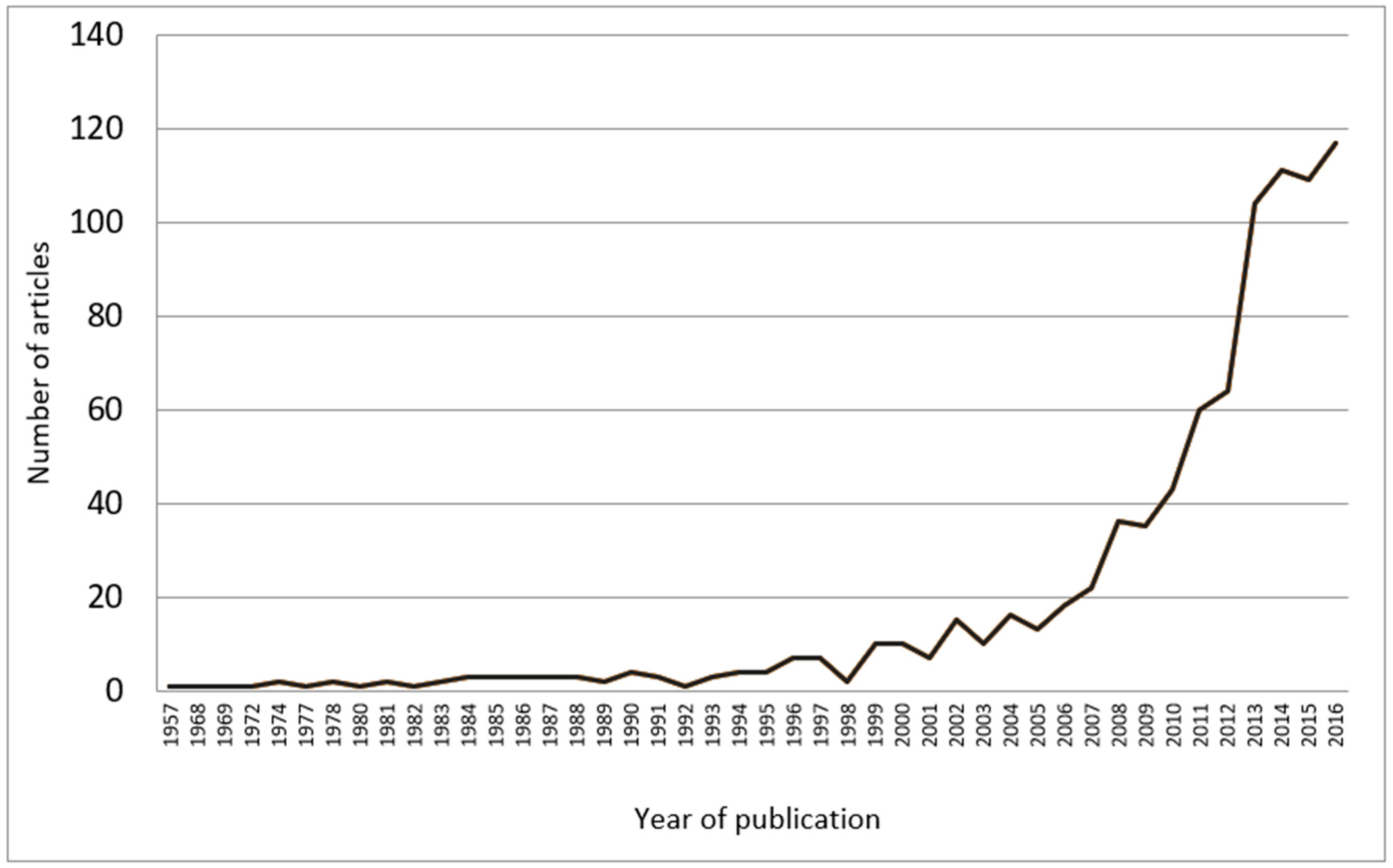
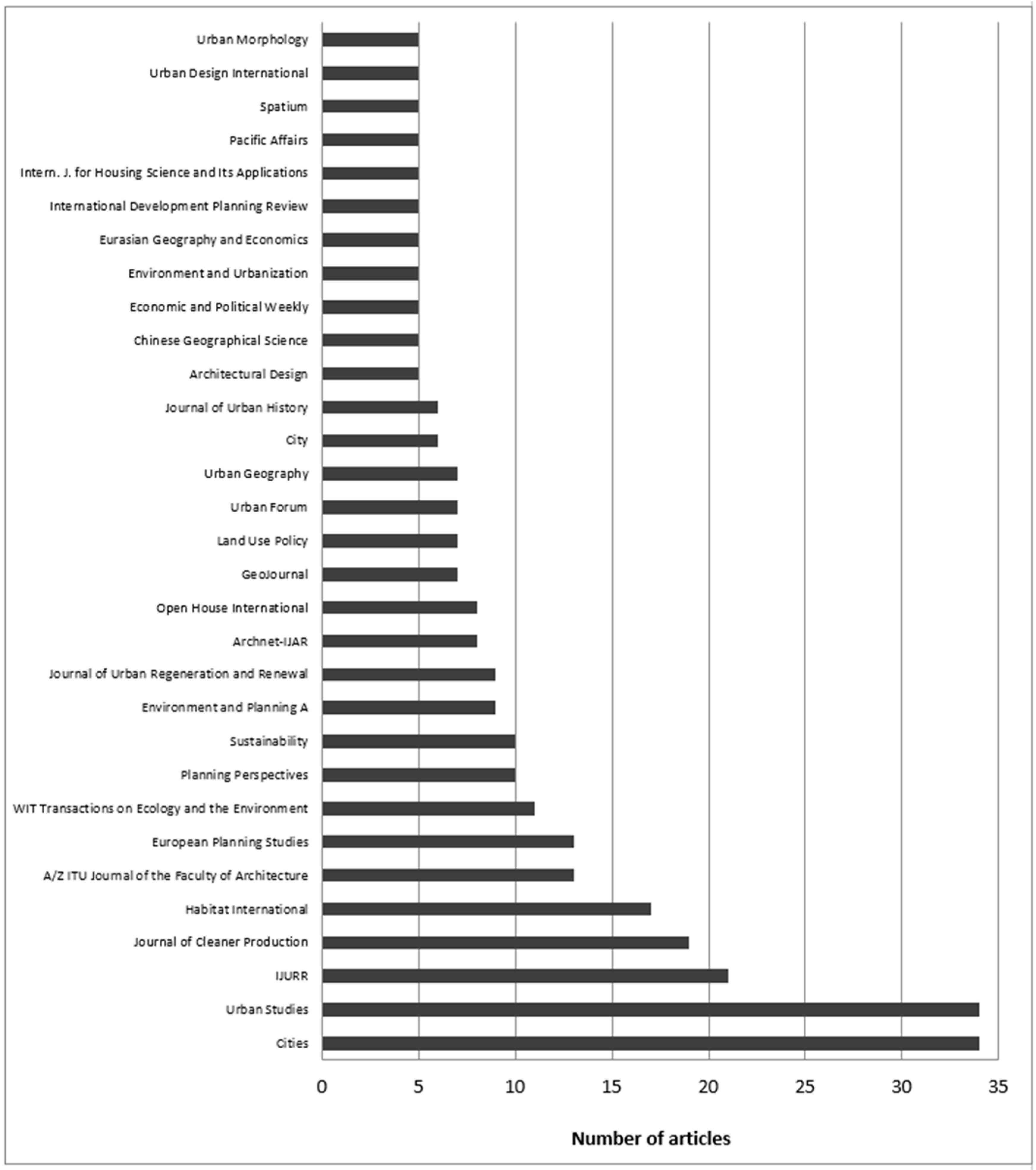
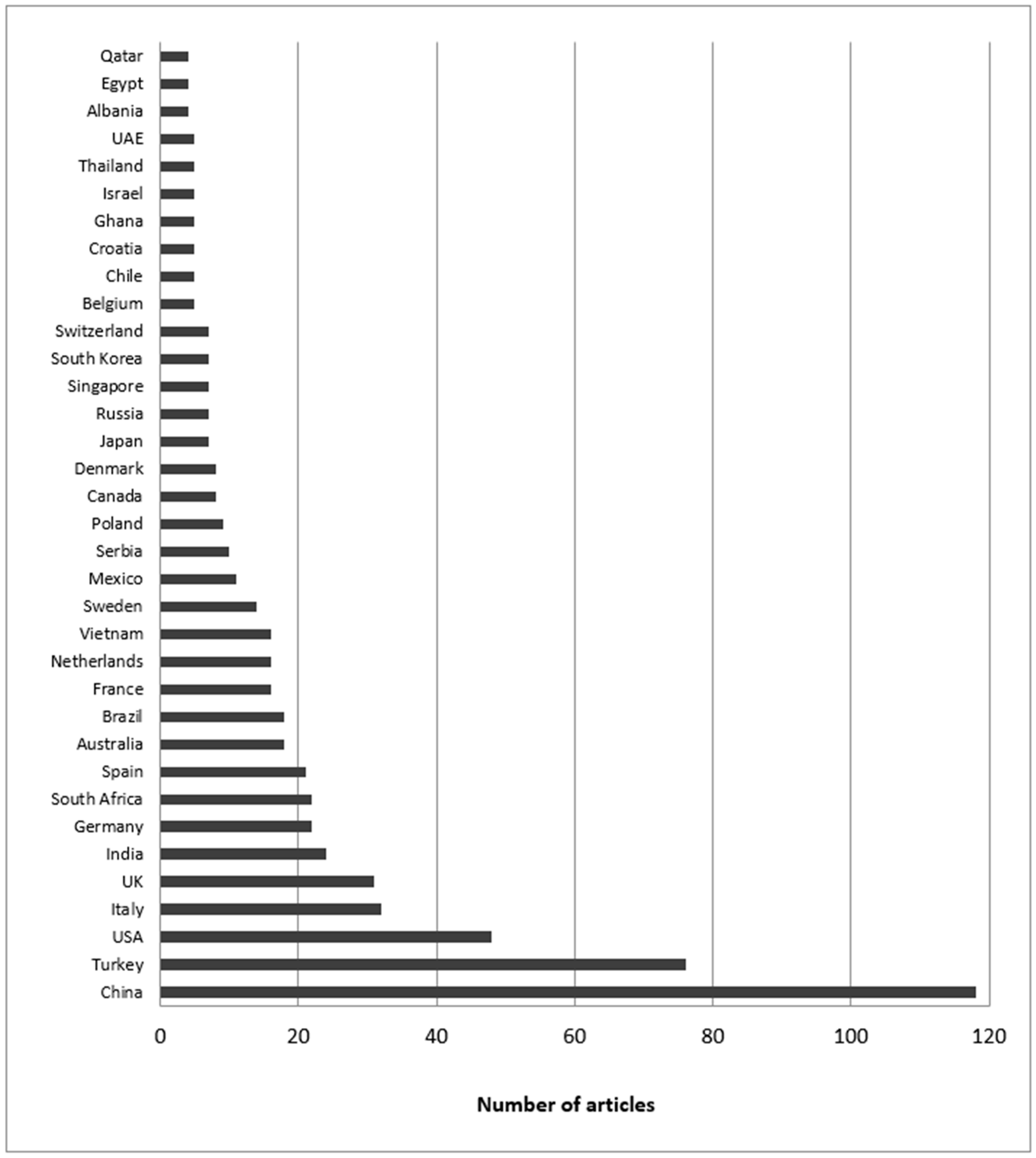
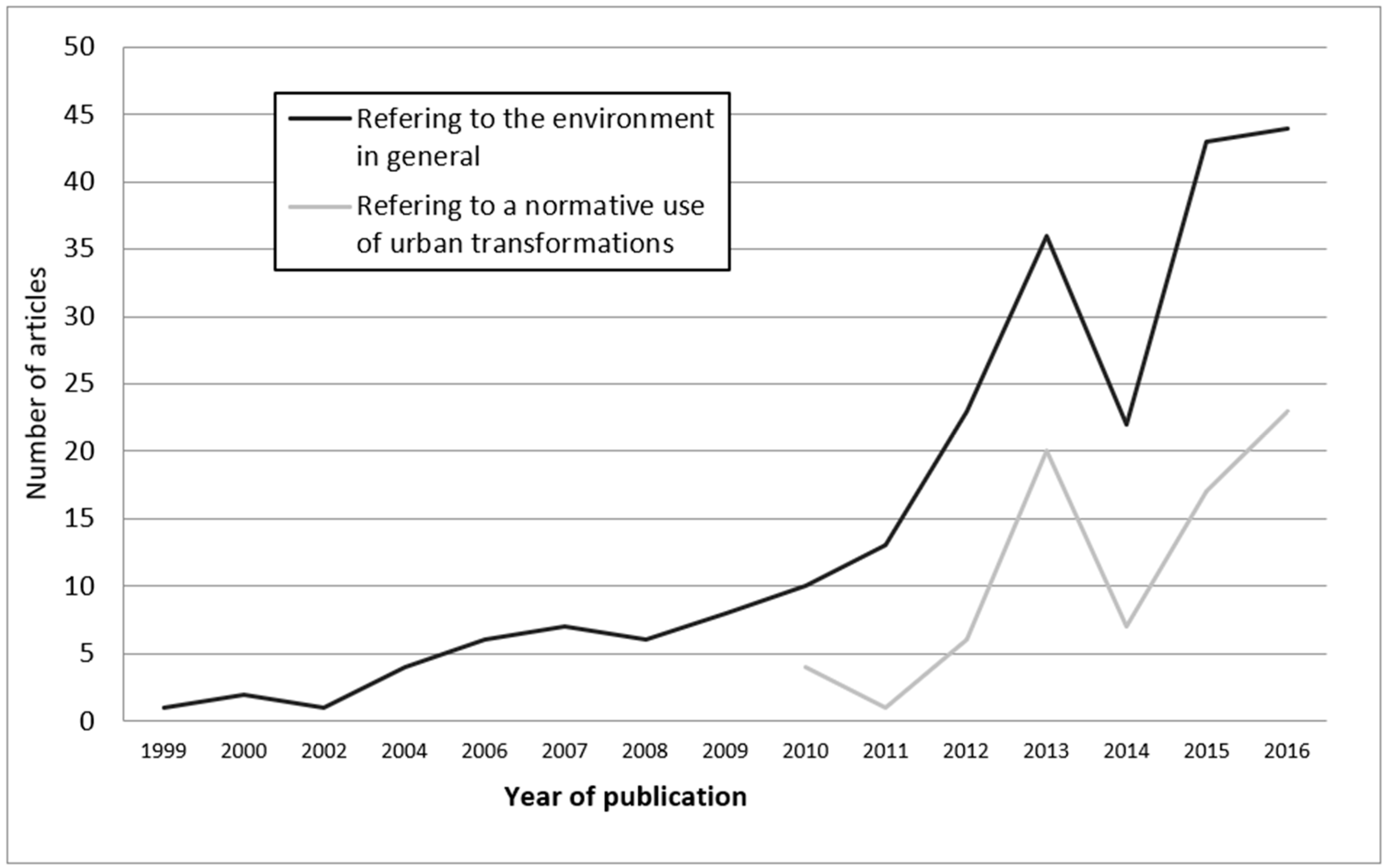
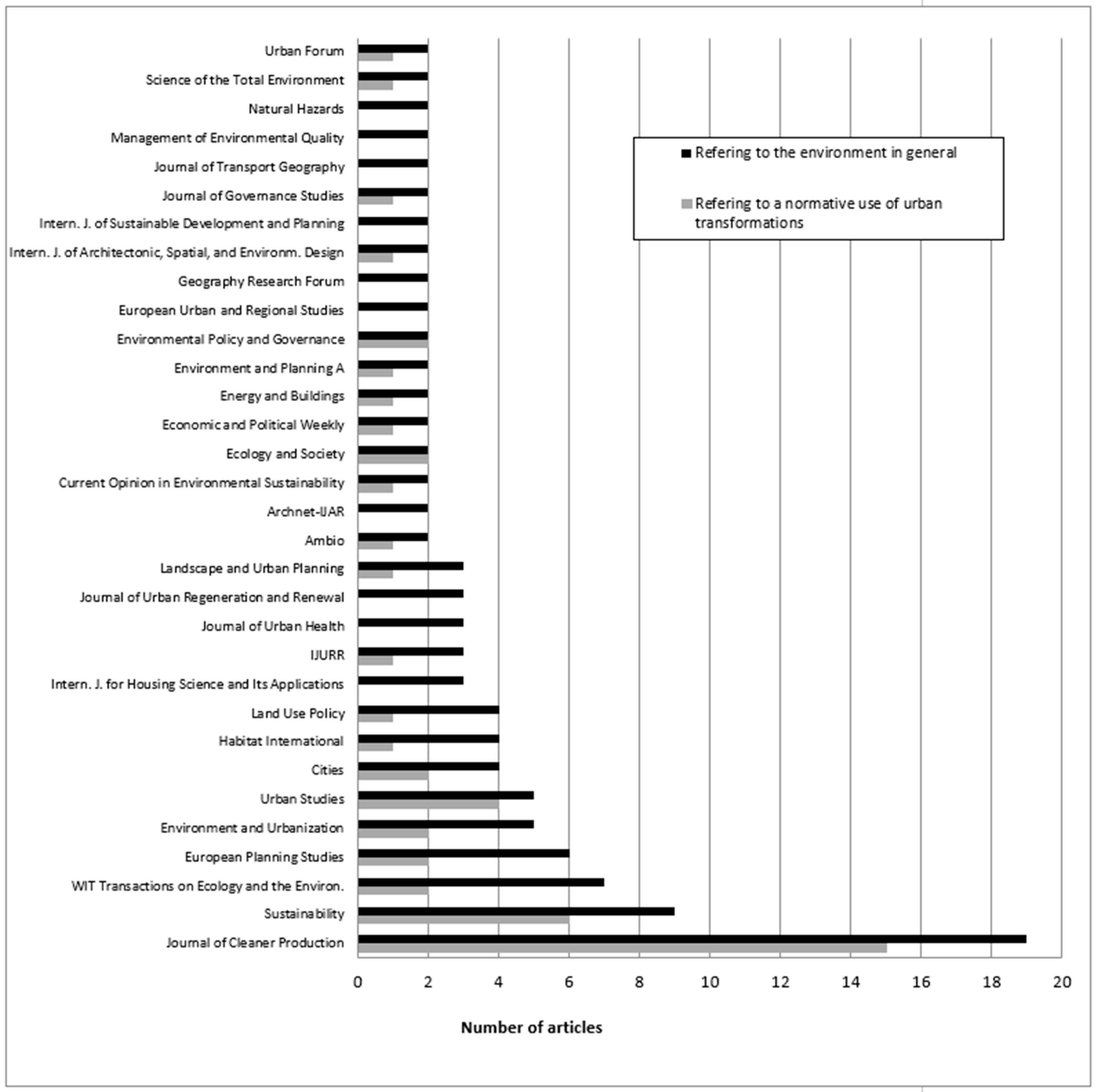
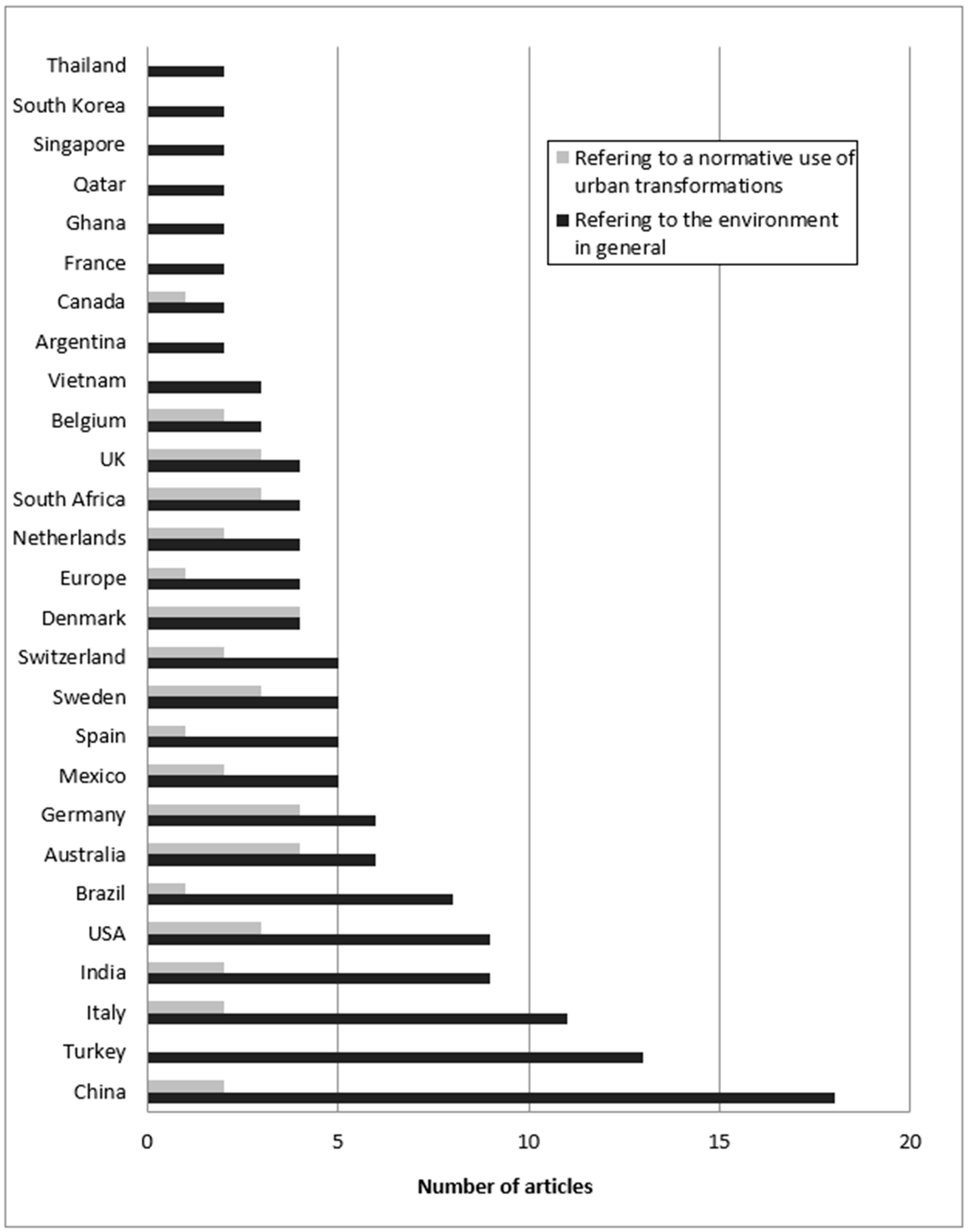
© 2017 by the authors. Licensee MDPI, Basel, Switzerland. This article is an open access article distributed under the terms and conditions of the Creative Commons Attribution (CC BY) license (http://creativecommons.org/licenses/by/4.0/).
Share and Cite
Koch, F.; Kabisch, S.; Krellenberg, K. A Transformative Turn towards Sustainability in the Context of Urban-Related Studies? A Systematic Review from 1957 to 2016. Sustainability 2018, 10, 58. https://doi.org/10.3390/su10010058
Koch F, Kabisch S, Krellenberg K. A Transformative Turn towards Sustainability in the Context of Urban-Related Studies? A Systematic Review from 1957 to 2016. Sustainability. 2018; 10(1):58. https://doi.org/10.3390/su10010058
Chicago/Turabian StyleKoch, Florian, Sigrun Kabisch, and Kerstin Krellenberg. 2018. "A Transformative Turn towards Sustainability in the Context of Urban-Related Studies? A Systematic Review from 1957 to 2016" Sustainability 10, no. 1: 58. https://doi.org/10.3390/su10010058
APA StyleKoch, F., Kabisch, S., & Krellenberg, K. (2018). A Transformative Turn towards Sustainability in the Context of Urban-Related Studies? A Systematic Review from 1957 to 2016. Sustainability, 10(1), 58. https://doi.org/10.3390/su10010058





